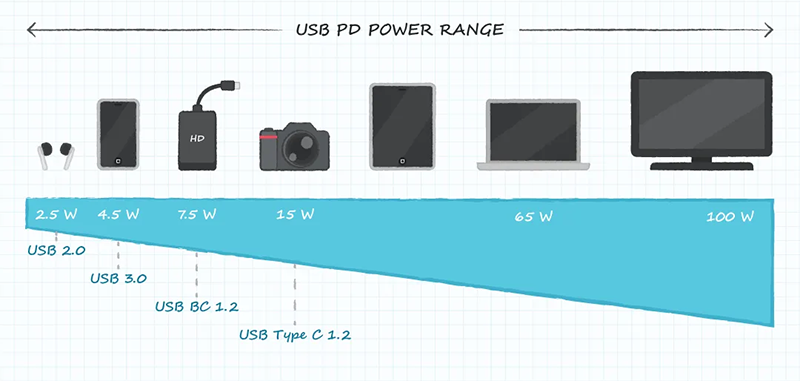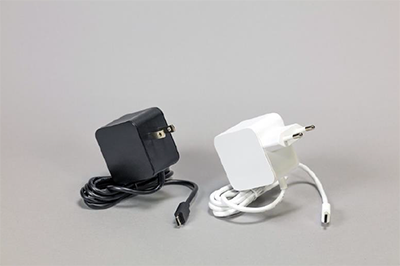In our ever-connected world, a universal charging solution has become a necessity. Imagine being able to charge your smartphone, laptop, tablet, and even some appliances with a single cable and charger. That's where USB Power Delivery (USB-PD) steps in – a game-changing technology that's reshaping the way we power and charge our devices.
Before we jump into the details of USB-PD, let's look at the state of charging technology a few years ago. You probably have a drawer filled with various chargers, each with a different connector and power rating. Charging your smartphone with your laptop charger? Forget about it. Charging your tablet with your camera charger? Not a chance. It was a world of tangled cables and compatibility issues.
What is USB-PD?
USB-PD, short for USB Power Delivery, is a standardized protocol and specification designed to deliver higher levels of power and greater flexibility in charging and powering electronic devices. In simpler terms, it's a universal power solution that eliminates the need for multiple chargers and cables.

Figure 1: USB-PD Power Range (Source: CUI, Inc.)
Remember the frustration of hunting for the right charger or cable when you needed to charge your various gadgets? With USB-PD, you can charge a wide range of devices, from smartphones and laptops to monitors and small appliances, all using a single cable and charger. No more clutter of tangled cables or confusion over which charger goes with what device.
Key Features of USB Power Delivery:
Increased Power Levels: USB-PD supports power levels from 5W to 100W or more. This means it can handle the charging needs of not just your smartphone, but also power-hungry devices like laptops and smaller household appliances.
Bi-Directional Power Flow: USB-PD allows power to flow in both directions. This means your laptop can charge your smartphone, or two laptops can share power between each other.
Negotiation of Power Levels: USB-PD devices communicate with each other to determine the right power level and voltage needed for charging or powering. This ensures safe and efficient power delivery based on the connected devices' capabilities.
Variable Voltage and Current: USB-PD can deliver power at various voltage and current levels, adapting to the specific requirements of the device. This helps prevent overcharging and ensures that your devices get the right amount of power.
USB Type-C Connector: USB-PD is often associated with the USB Type-C connector. This reversible and versatile connector can handle higher power levels and data transfer, making it a perfect match for USB-PD technology.
Fast Charging: USB-PD supports fast-charging capabilities, ensuring your devices charge quickly and efficiently.
Universal Compatibility: One of USB-PD's primary goals is universal compatibility. It's supported by numerous device manufacturers, making it easier for you to use a single charger or power bank for all your devices.
Does the Raspberry Pi 5 Support USB-PD?
 Yes! A new feature on the Pi 5 is support for USB-PD. There's a new official power supply for the Pi5: the 27W USB-C PD Power Supply . Normally, the total power available at the Pi 5's four USB ports is limited to a nominal 600mA. When the new power supply is detected, that increases to 1.6A, letting the Raspberry Pi 5 power a much wider range of peripherals.
Yes! A new feature on the Pi 5 is support for USB-PD. There's a new official power supply for the Pi5: the 27W USB-C PD Power Supply . Normally, the total power available at the Pi 5's four USB ports is limited to a nominal 600mA. When the new power supply is detected, that increases to 1.6A, letting the Raspberry Pi 5 power a much wider range of peripherals.
Embracing the Future of Charging
USB-PD has quickly become a standard in the tech industry, simplifying power management and improving the user experience when it comes to charging and powering electronic devices. With its ability to deliver higher power, fast-charging capabilities, and universal compatibility, it's a technology that's transforming the way we stay connected.
For more information on USB-C and USB-PD, check out Tech Spotlight: What's Coming Up in the Changing World of USB?

Top Comments
-

wolfgangfriedrich
-
Cancel
-
Vote Up
0
Vote Down
-
-
Sign in to reply
-
More
-
Cancel
-

cstanton
in reply to wolfgangfriedrich
-
Cancel
-
Vote Up
0
Vote Down
-
-
Sign in to reply
-
More
-
Cancel
-

wolfgangfriedrich
in reply to cstanton
-
Cancel
-
Vote Up
0
Vote Down
-
-
Sign in to reply
-
More
-
Cancel
-

cstanton
in reply to wolfgangfriedrich
-
Cancel
-
Vote Up
0
Vote Down
-
-
Sign in to reply
-
More
-
Cancel
-

wolfgangfriedrich
in reply to cstanton
-
Cancel
-
Vote Up
0
Vote Down
-
-
Sign in to reply
-
More
-
Cancel
Comment-

wolfgangfriedrich
in reply to cstanton
-
Cancel
-
Vote Up
0
Vote Down
-
-
Sign in to reply
-
More
-
Cancel
Children